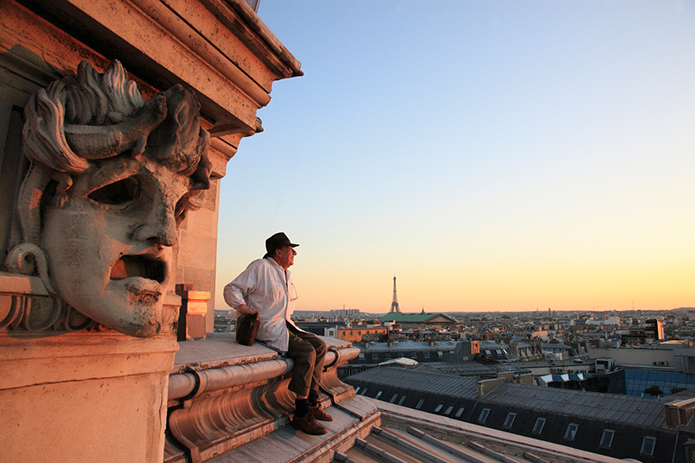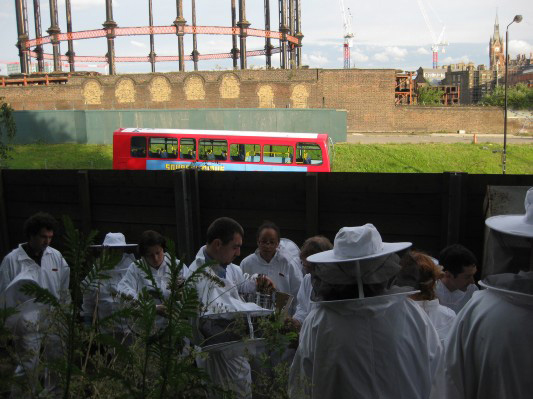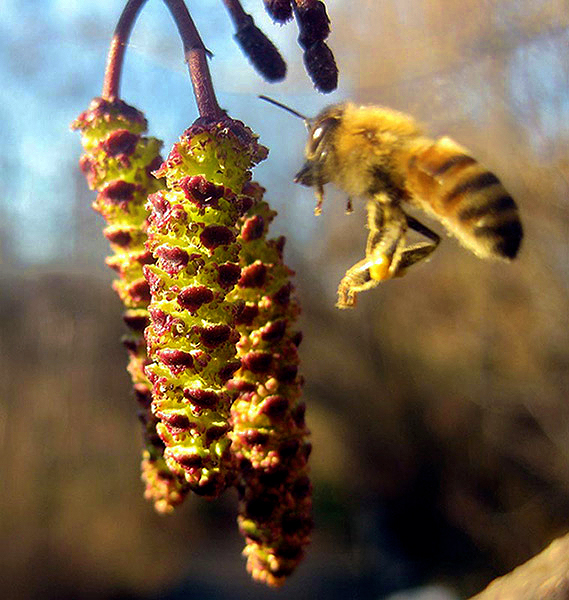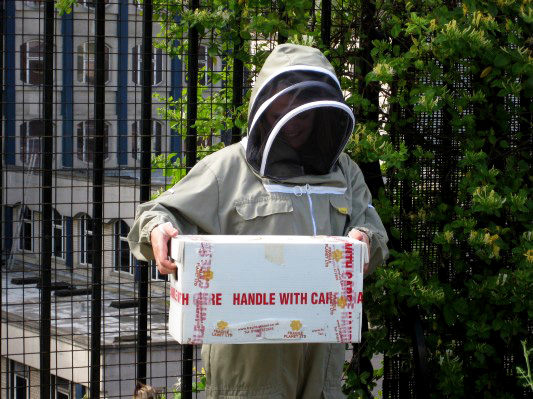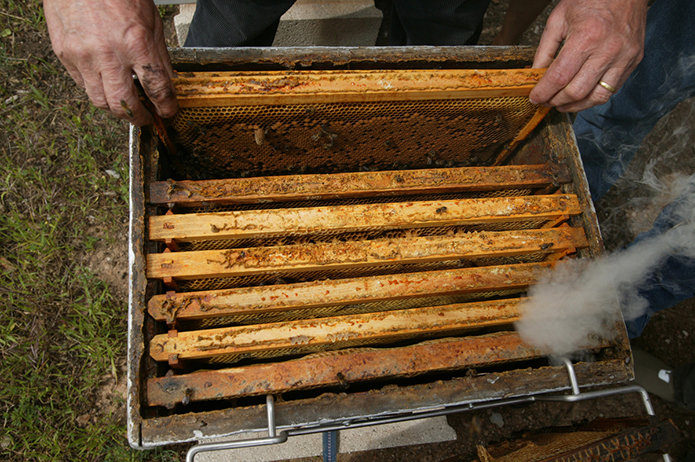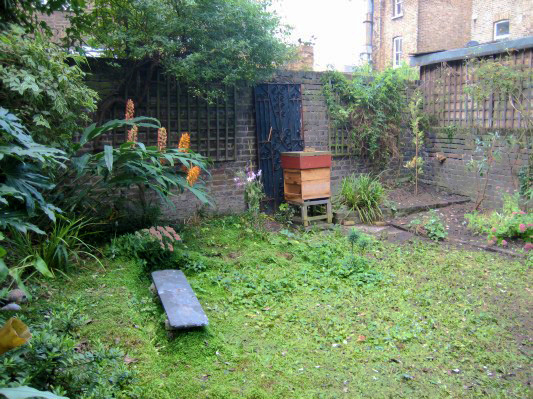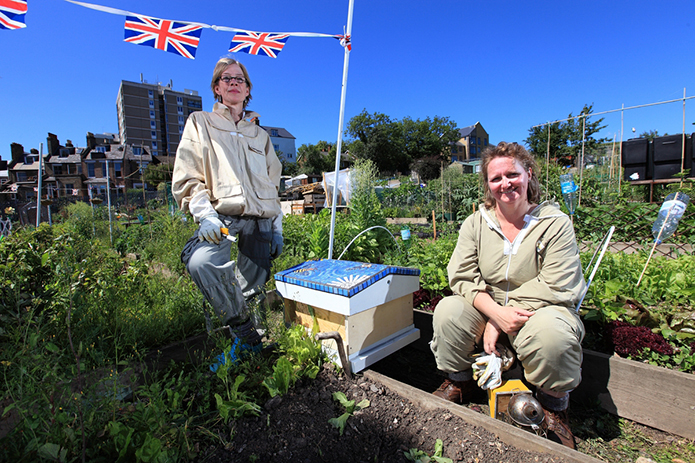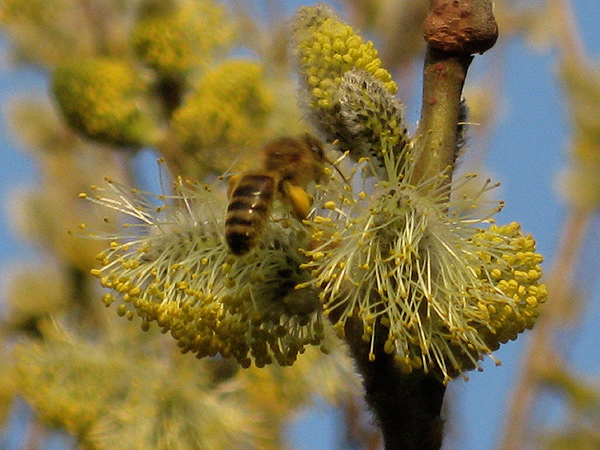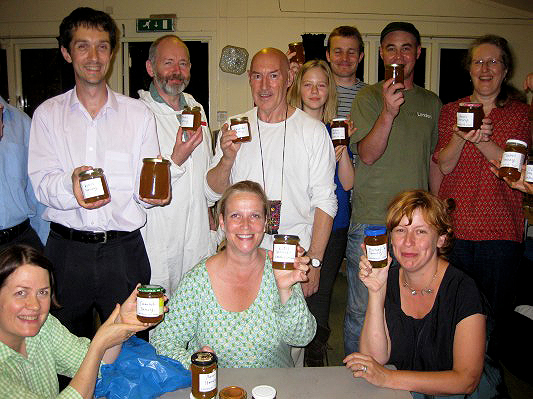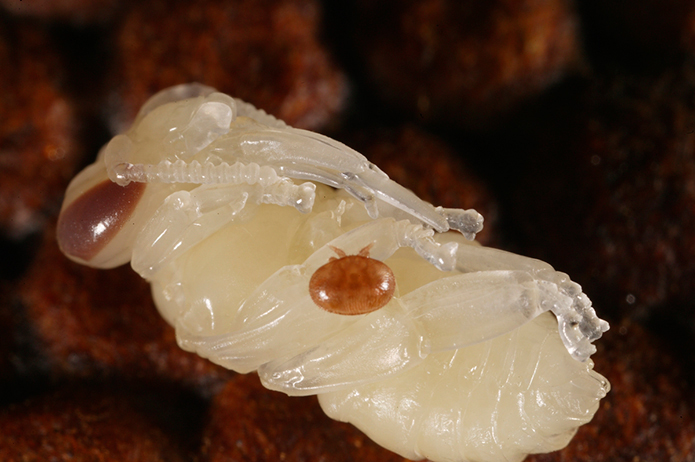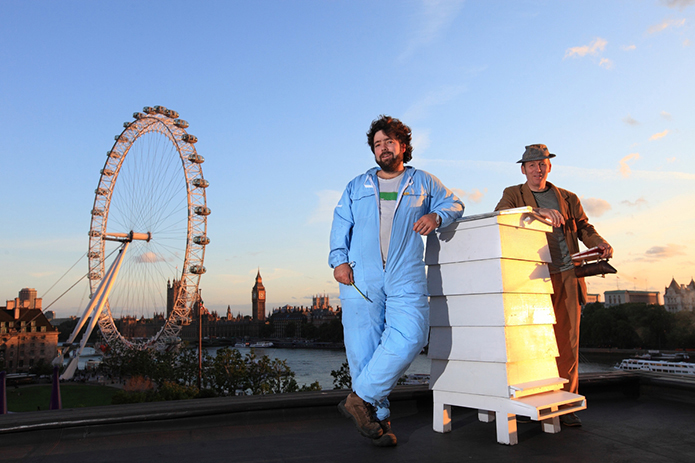
Hives on the roof of the Royal Festival Hall, London. Image © Éric Tourneret / www.thehoneygatherers.com.
I’ve always had a soft spot for the gentle honey bee, rather than their angry Apocrita cousin the wasp, and encouraged their visits by planting wild flowers with vivid colours around the garden. I share an equally soft spot for their delicious, sweet, oozing honey. All is not well though in the honey bee world, and they’re under threat, largely due to the agricultural model of intensive monoculture and the excessive use of chemical herbicides, pesticides and fertilisers, leaving green deserts in the countryside, bereft of insects.
Whilst honey bees have been on the decline in rural areas, where we have lost 97% of our wild flower meadows, urban beekeeping has been on the increase in the past decade. The number of apiaries in cities such as London and Paris has more than doubled, and in the three years immediately after urban beekeeping was legalised in New York City in 2010, there were twice the number of hives as before, with many more planned.
It has even been suggested that by increasing the number of urban bee hives, and introducing more green roofs and urban gardens, urban beekeeping can play a key role in ensuring the bee’s survival, and in turn our system of natural food production, because without the bee, and without their help in pollinating crops, there will be dire consequences.
I wanted to explore why there has been a resurgence in urban beekeeping in recent years, what urban beekeeping actually entails, and what more can we do to ensure a sustainable future and Alison Benjamin, writer and co-founder of Urban Bees, kindly agreed to be interviewed to share her thoughts on the subject. Read on below.
About Alison Benjamin & Urban Bees
Alison Benjamin lives in London and is a Guardian journalist and co-founder of Urban Bees, a social enterprise helping to bring bees to cities, working to promote sustainable and responsible beekeeping through training courses from their apiary in King’s Cross and working in partnerships with a range of organisations and companies such as the Co-operative Group, Westminster Cathedral and London Wildlife Trust to fulfil the mission. Alison is also the co-author of several books, including Bees in the City: an Urban Beekeepers’ Handbook, Keeping Bees and Making Honey and A World Without Bees.
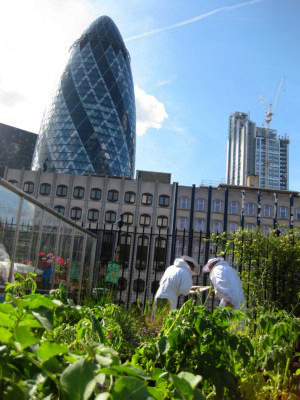
Urban Bees inspecting hives on the roof of Sir John Cass Primary School, London. Image © Urban Bees.
Firstly, can you explain to our readers who are unfamiliar with urban beekeeping, what it is that you do?
Myself and my partner, Brian McCallum, have a number of bee hives in different parts of London ranging from a small nature park, just behind King’s Cross station, to a cemetery park in east London. We are also working with a range of companies and organisations, such as Grosvenor Estates in Mayfair and Belgravia and KPMG in Canary Wharf.
These apiaries are used to train people and communities to become responsible urban beekeepers and they also produce honey which we harvest throughout the summer. If the spring and summer is dry and warm, the bees will make enough honey that we can harvest about 40lbs from each hive. The wet summer in 2012 followed by a late summer in 2013 reduced the amount of honey the bees were able to make, but summer 2014 was much better for urban honey production because it was dry and warm.
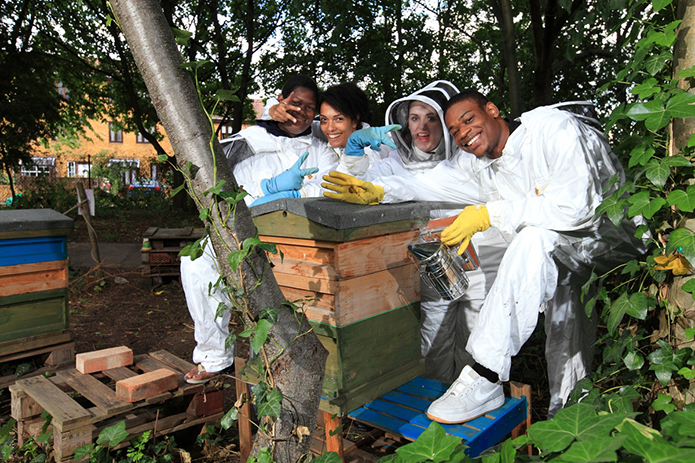
Disadvantaged young people in inner city London learning about beekeeping and entrepreneurialism through keeping bees and selling honey. Image © Éric Tourneret / www.thehoneygatherers.com.
Why are urban areas particularly suitable for beekeeping?
Towns and cities have a much broader range of flowers that provide nectar and pollen for bees throughout the year than rural areas, where one field may be in bloom in April but then there is nothing else for the bees to eat all year. In urban areas, there are many disused areas such as railway sidings and cemeteries and wildlife parks where particularly bee-friendly plants such as brambles and buddleia are allowed to grow wild. There is also less use of weed killers in the parks and streets where bees forage on trees and flowers.
Is there a particular ‘type’ of person that keeps bees, or is it people from all walks of life?
Beekeeping used to be for retired country gentleman, but in the last decade younger people in their 30s and 40s, including many women have been taking it up in towns and cities.
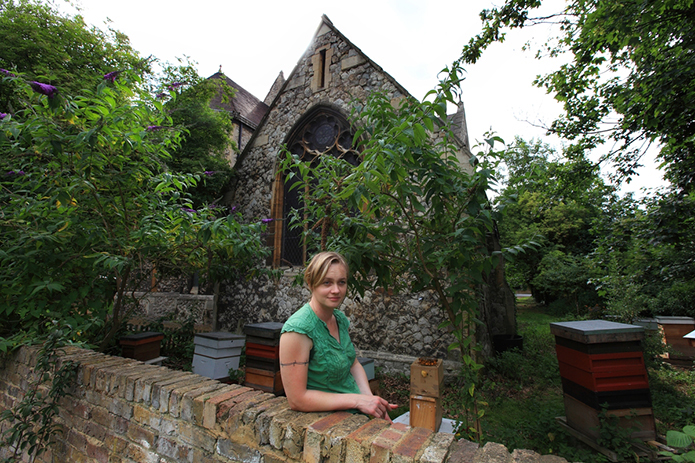
Hives in the garden of St Peters Church, Brockley. Image © Éric Tourneret / www.thehoneygatherers.com.
How much time, money and space is required to get started and maintain a healthy hive?
Beekeeping’s not a cheap hobby. Initial set up costs are around £1,000. This includes all the hive, bee suit (don’t try beekeeping without it as a beginner) and all the other equipment for inspecting your hive and harvesting the honey, plus training and the bees themselves which can cost up to £200 from a reputable bee supplier and can be hard to find if you leave it to late (best order in the winter for the following spring). Ongoing costs are around £200 a year for honey jars, new bits of equipment.
Time-wise, an hour a week from April to September to check all is well in your hive and to add extra storage space for honey. (You don’t open the hive when it’s cold in winter) It doesn’t sound much but it soon becomes more – ordering equipment, being prepared for what your bees are going to do. And it’s best not to go away in April and May when your bees are building up and may swarm. Not only does swarming alarm the neighbours, but you lose half your bees, possibly more (and they are your honey makers).
Neighbours are your main consideration as an urban beekeeper. It’s not so much about the distance you need to have your hive from them, it’s more about them not being around in the garden when you check your hive once a week. This is the ONLY time your bees may get a bit defensive and are likely to sting. So find a time when your neighbours don’t use the garden or roof terrace.
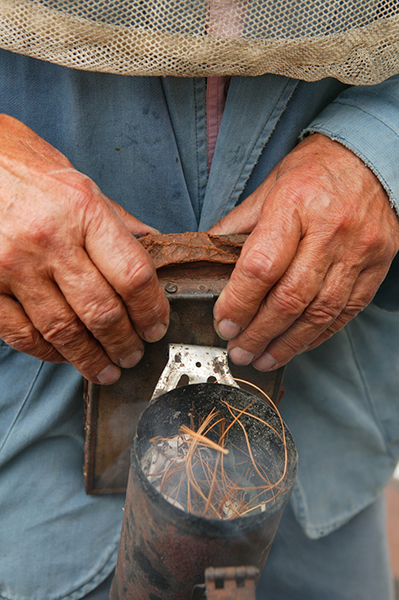
The smoker and its use in the art of smoking bees is one of the secrets of beekeeping, making it possible to control the behaviour of bees. Image © Éric Tourneret / www.thehoneygatherers.com.
It’s easier for you to inspect your hive in the middle of the day when most bees are out foraging but you may have to compromise or be flexible as and when your neighbours are out. We now live in a house with a garden that is overlooked by seven different sets of neighbours, with gardens and roof terraces at the sides and back that we wouldn’t feel comfortable having a hive. If the same 60ft garden was an end of terrace with no one at the back, and neighbours to one side, as was the case in our previous house we’d happily have a hive.
What do you attribute the surge in popularity for urban beekeeping to over the past decade?
Beekeeping’s become popular with people like myself who work in offices all day and are cut off from the changing seasons. It helps to reconnect with nature. People are also doing it to help save the bees (although there are better ways to save bees, such as planting bee-friendly flowers), to increase pollination and biodiversity and also to make their own honey.
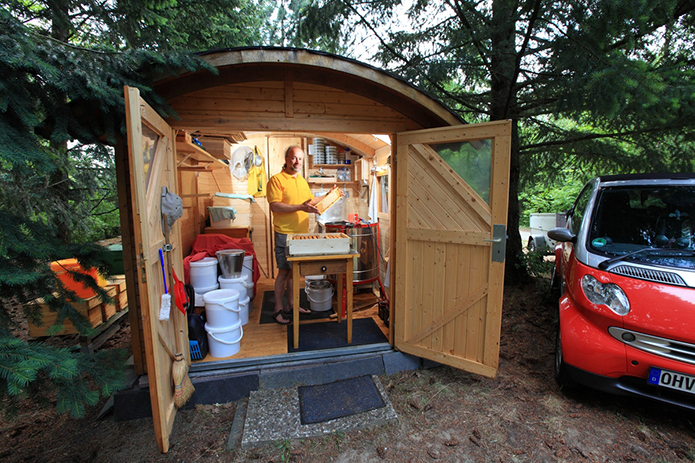
Apiary set up in Luisen-Friedhof cemetery, Berlin. Image © Éric Tourneret / www.thehoneygatherers.com.
Many allotments now have bees as they pollinate the fruit and vegetables and make another locally sourced food; honey. It’s all part of trying to lead a greener way of life. You can also make candles from the beeswax and cosmetics.
What more can individuals, businesses and organisations do to encourage a healthy population of bees in urban areas?
Planting melliferous plants and trees in their garden or allotment, and lobbying councils to plant more bee-friendly trees in streets and parks. We also need a lot more ‘living’ roofs that could provide wildlife havens for all pollinators, not just honeybees.
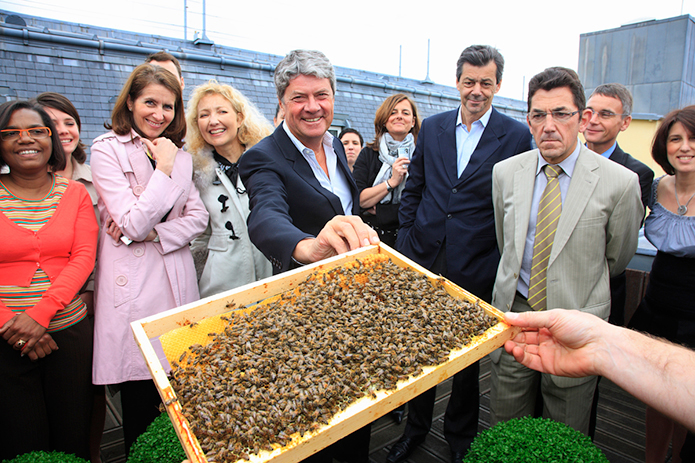
Inauguration of the hive on the terrace of the headquarters of Louis Vitton in Paris in the presence of Yves Carcelle, CEO of Louis Vitton. Image © Éric Tourneret / www.thehoneygatherers.com.
Given the rise in numbers of apiaries in urban areas, is there a danger that there won’t be enough natural forage to support the increased numbers of honey bees?
Not enough research has been done to show how much forage a healthy colony of urban honeybees requires, but we do know that in addition to honeybees there are bumblebees and solitary bees that will also be looking for a similar food source. Honey yields have been down but this could be due to the poor weather. But there is no doubt that urban beekeeping must go hand in hand with increasing forage in towns and cities.
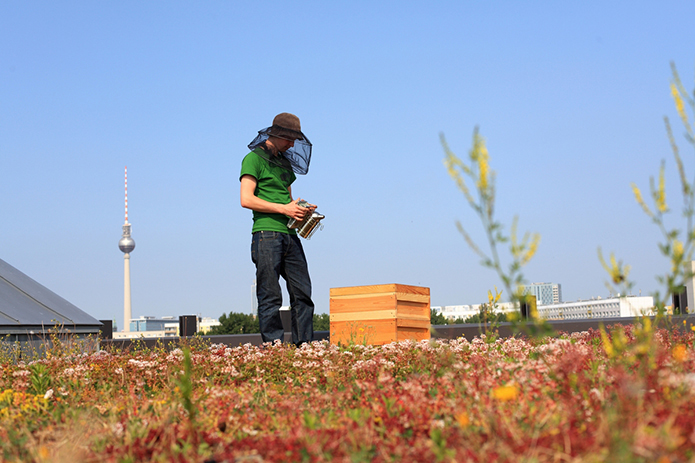
Hive on the roof of Church of the Resurrection, Berlin. Image © Éric Tourneret / www.thehoneygatherers.com.
Where do the bees in your hives forage their nectar from, is it trees sources or flowers, or both, and how far afield do they travel to forage?
There are different sources of forage at different times of the year. Hazel, alder and pussy willow trees are very important in early spring, not for nectar but for the catkins which produce much-needed pollen for the baby bees. London lime trees provide a huge amount of nectar in June and July, and the chestnut trees and brambles. Honeybees are said to travel around 3 miles for food, but it’s unlikely they’d need to do that in an urban area with tree lined streets, parks and gardens.
Are there differences in taste and quality of the honey throughout the season depending on the different sources that they’re foraging on at a particular time in the year?
Yes, the predominately lime honey has a very light taste with a hint of citrus. The mainly chestnut honey is thicker and amber coloured with a slight caramel flavour. Urban honey tends to be polyfloral as the nectar will come from a variety of flowers in bloom at any one time.
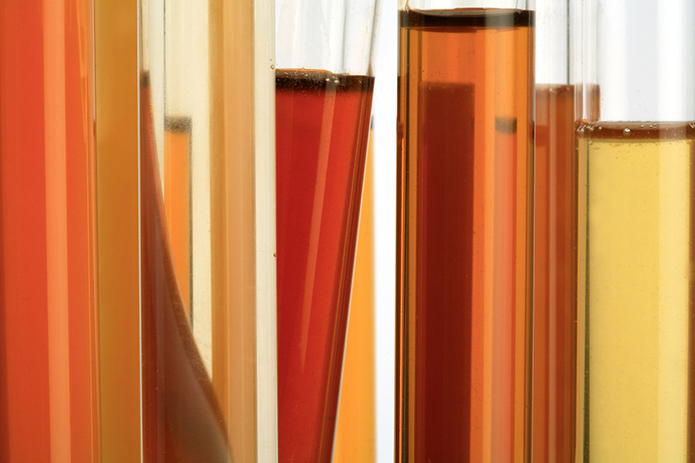
Various hues of honey; the colour indicating its origin. Image © Éric Tourneret / www.thehoneygatherers.com.
Are the any legal restrictions on keeping a hive, for instance, the type of hive, where it’s placed, proximity to neighbours, and do you require a licence?
There are no legal restrictions yet, although if you want one on an allotment check their rules and regulations. Freeholders should also be informed. Many businesses that don’t own their office building have to tell managing agents and freeholders and go through health and safety procedures before a hive can be installed. It’s a good idea to speak to neighbours. Beekeeping was banned in New York until 2010 as honeybees were classified as dangerous animals, but that was overturned due to popular demand.
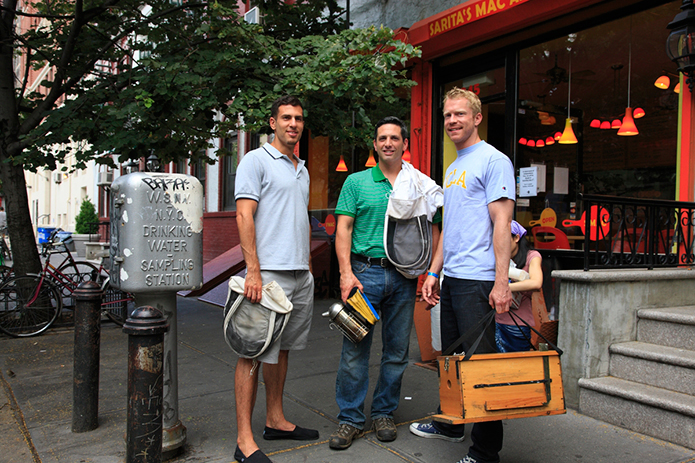
Young members of New York City Beekeepers’ Association on their way to inspect hives in the East Village. Image © Éric Tourneret / www.thehoneygatherers.com.
How does the honey that you harvest compare to supermarket honey?
Our honey is pure. Straight from the honey comb into a bucket and then jarred. Supermarket honey is often a blend of different EC and non EC (Argentina, China) honey and it is heated in some way. You don’t get the seasonal difference with supermarket honey. People say ours is the best they’ve ever tasted with a lot of different layers to the subtle taste.
Is it true that eating local honey can help alleviate hay fever, and if so, why is this?
It’s not medically proven, but it makes sense that if you eat local honey containing minuscule grains of the pollen you have an allergy to, that you could build up an immunity to hay fever. People swear by it.
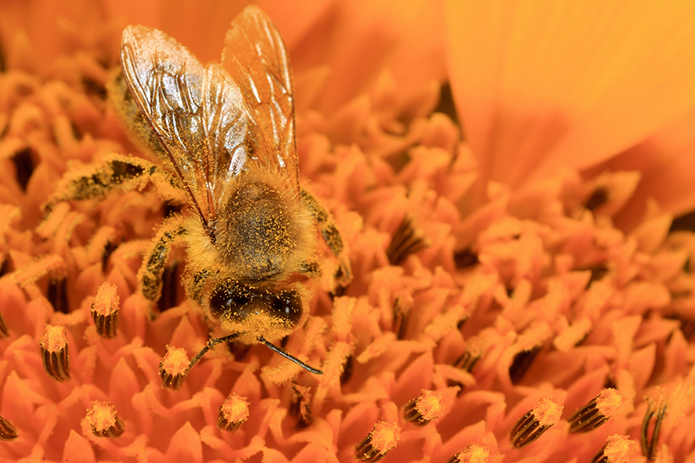
A bee shrouded in pollen as it harvests nectar; involuntarily pollinating the plant. Image © Éric Tourneret / www.thehoneygatherers.com.
How important is training to ensuring that hives are managed safely and sustainably?
It’s very important to go on a training course before you keep bees, ideally to shadow an experienced beekeeper for a year or to join a beekeeping association and visit their apiary throughout the summer to get a real sense of what beekeeping entails. Much beekeeping involves looking at grubs – the eggs and larvae in the hive (what’s called the brood) as this tells you more about the health of the colony than adult bees.

Progression of a bee egg to the larva stage, then the pupa lacking any pigmentation, then up to the final stage before birth, taking on its pigment. Image © Éric Tourneret / www.thehoneygatherers.com.
And you have to watch out for and treat your bees for varroa – the parasitic mite that lives on the honeybees, weakens it and transports lethal viruses. It’s very different from the idyllic image of the hive at the end of the garden and happy bees coming back with nectar and pollen.
What’s the most enjoyable aspect of beekeeping for you?
Beekeeping has opened a whole new world of nature to me. I love knowing when certain flowers and trees are in bloom and which plants the bees are visiting – you can tell from the colour of the pollen on their back legs. I am now aware of summer starting in April rather than the August school holidays. I now realise that I didn’t need to keep honeybees to connect with nature – I could have planted bee-friendly flowers and watched the bumblebees in the garden or installed a solitary bee house – but for me they have been a catalyst for understanding other bees and pollinators and their vital role in our ecosystem and the great well-being that greening cities could bring people as well as bees.
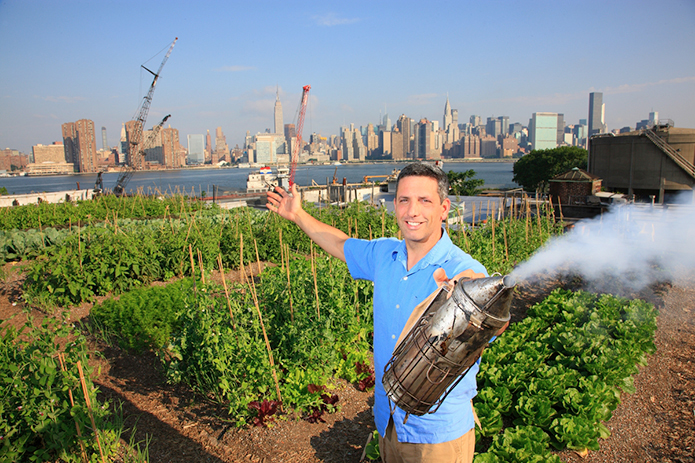
Apiary set up in a new organic farm, on the roof of a building in Brooklyn, overlooking Manhattan. Image © Éric Tourneret / www.thehoneygatherers.com.
Thanks to Alison Benjamin for taking time out to answer our questions. To learn more about urban beekeeping, Urban Bees runs taster courses for beginners periodically throughout the year. For more information, please visit Urban Bees’ website by clicking the link below:

